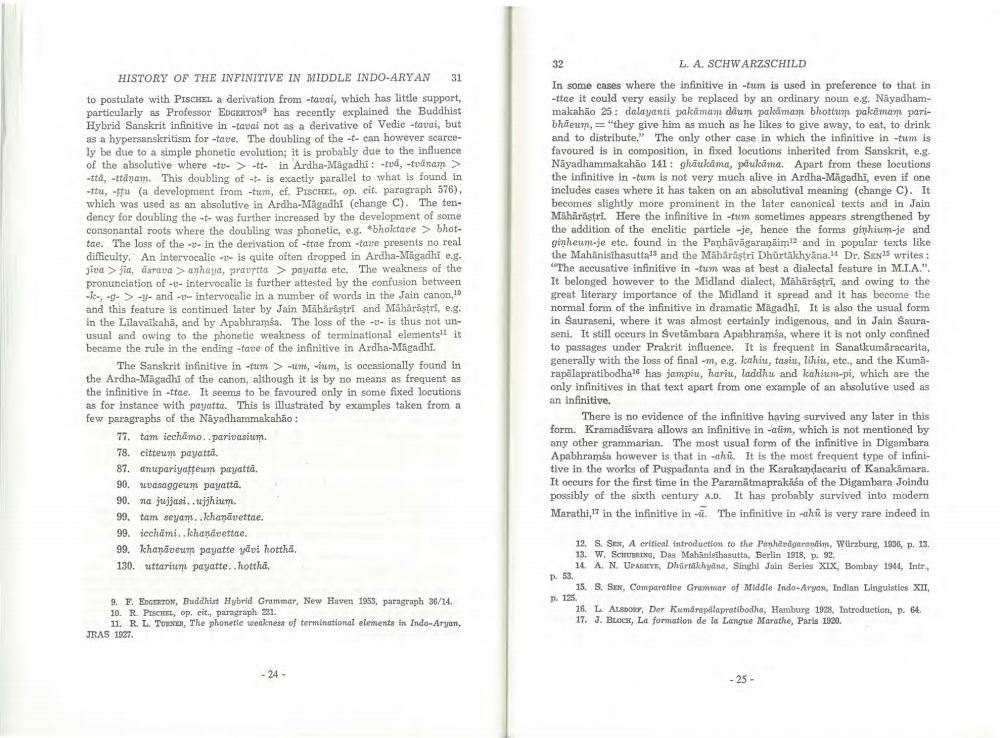________________
HISTORY OF THE INFINITIVE IN MIDDLE INDO-ARYAN 31 to postulate with PISCHEL a derivation from -tapai, which has little support, particularly as Professor EDGERTON has recently explained the Buddhist Hybrid Sanskrit infinitive in tavai not as a derivative of Vedic -tavai, but as a hypersanskritism for tave. The doubling of the -- can however scarcely be due to a simple phonetic evolution; it is probably due to the influence of the absolutive where -to->-t- in Ardha-Magadhi: tod, to sam
sta, staram. This doubling of is exactly parallel to what is found in -ttu, -u a development from tum, cf. PISCHE, op. cit. paragraph 576). which was used as an absolutive in Ardha-Magadhi (change C). The tendeney for doubling the -- was further increased by the development of some consonantal roots where the doubling was phonetic, eg, bholetave > bhottae. The loss of the --- in the derivation of tree from tave presents no real difficulty. An intervocalie is quite often dropped in Ardha-Magadhf e.g. jiva > ja asrare > anhana, praurtta > payatta etc. The weakness of the pronunciation of -- intervocalie is further attested by the confusion between ----> -- and wintervocalie in a number of words in the Jain canon, to and this feature is continued later by Jain Maharastri and Maharastri, e.g. in the Lilavaikahā, and by Apabhrapša. The loss of the -- is thus not unusual and owing to the phonetic weakness of terminational elementsil it became the rule in the ending -tave of the infinitive in Ardha-Magadhi
The Sanskrit infinitive in tum > - , -um, is occasionally found in the Ardha-Magadhi of the canon, although it is by no means as frequent as the infinitive in Itae. It seems to be favoured only in some fixed locutions as for instance with payatta. This is illustrated by examples taken from a few paragraphs of the Nayadhammakahko:
77. tam icchamo..parivasium 78. citteum payatra. 87. anupariyatteun payatta 90. vesaggeum payatta. 90. na jujjasi.. jjhium. 99. tam seyam. Ihanāvettae. 99. iechami.khanavettae. 99. khanaveur payatte ydi hottha. 130.uttarit payatte.hottha
L. A. SCHWARZSCHILD In some cases where the infinitive in tam is used in preference to that in
ttae it could very easily be replaced by an ordinary noun e.g. Nāyadhammakahão 25 : dalayanti palomam ddum palmam bhot palamam paribhaeum, "they give him as much as he likes to give away, to eat, to drink and to distribute." The only other case in which the infinitive in tam is favoured is in composition, in fixed locutions inherited from Sanskrit, e.g. Nāyadhammakahão 141: ghakima, palama. Apart from these locutions the infinitive in tum is not very much alive in Ardha-Magadhi, even if one includes cases where it has taken on an absolutival meaning (change C). It becomes slightly more prominent in the later canonical texts and in Jain Maharastri. Here the infinitive in tom sometimes appears strengthened by the addition of the enelitie particle -je, hence the forms gilim-je and gishenje etc. found in the Panhavagaranaim and in popular texts like the Mahnisihasutta and the Maharastri Dhurtākhyāna. Dr. Sexs writes: "The accusative infinitive in tum was at best a dialectal feature in M.I.A.". It belonged however to the Midland dialect, Maharlestri, and owing to the great literary importance of the Midland it spread and it has become the normal form of the infinitive in dramatie Magadhi. It is also the usual form in Sauraseni, where it was almost certainly indigenous, and in Jain Sauraseni. It still occurs in Svetambara Apabhramsa, where it is not only confined to passages under Prakrit influence. It is frequent in Sanatkumaracarita, generally with the loss of final-m, e.g. Joahit, taste, tihin, etc., and the Kumarapalapratibodha" has jampiu, hariu, laddhu and kahium-pi, which are the only infinitives in that text apart from one example of an absolutive used as an infinitive.
There is no evidence of the infinitive having survived any later in this form. Kramadišvara allows an infinitive in-aim, which is not mentioned by any other grammarian. The most usual form of the infinitive in Digambara Apabhramba however is that in th. It is the most frequent type of infinitive in the works of Puspadanta and in the Karakandacariu of Kanakamara It occurs for the first time in the Paramātmaprakasa of the Digambara Joindu possibly of the sixth century A.D. It has probably survived into modern Marathi," in the infinitive in . The infinitive in-ahü is very rare indeed in
12. S. Sex, A critical introduction to the Past
Wurzburg, 1906, p. 13. 13. W. SCHINO, Das Mahinshasutta, Berlin 1918, p. 32 14. A N. UPARK, Dhah , Sinchi Jain Series XIX, Bombay 1941. Inte
9. F. EGSTON, Buddhist Hybrid Grammar, New Haven 1953, paragraph 36/14 10. R. PISCHE, op. cit., paragraph 231.
11. R. L. TU , The phonetle weakness of terminational elements in Indo-Aryan, JRAS 1921.
15. S. Sex, Comparative Grammar of Middle Indo-Ary, Indian Linguistics XII, 16. LADY, Der Kumpileprotibodhe, Hamburg 1998, Introduction, p. 64. 17. J. BLOCK, La formation de la langue Marthe, Paris 1520
.24 -




